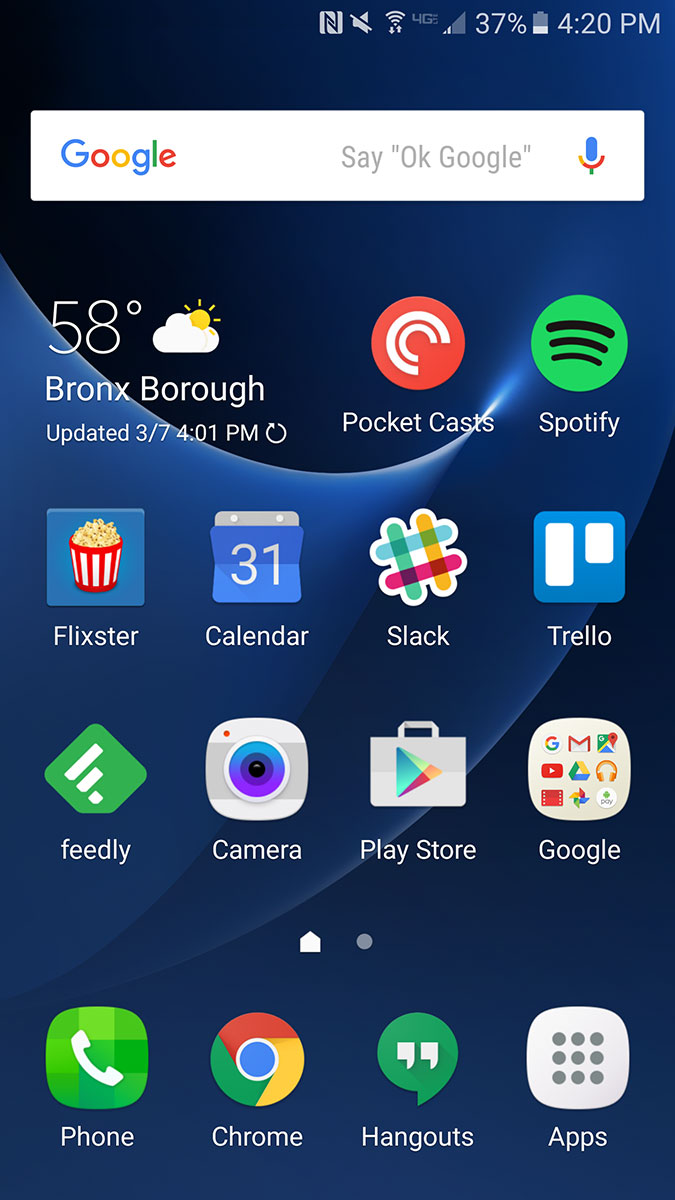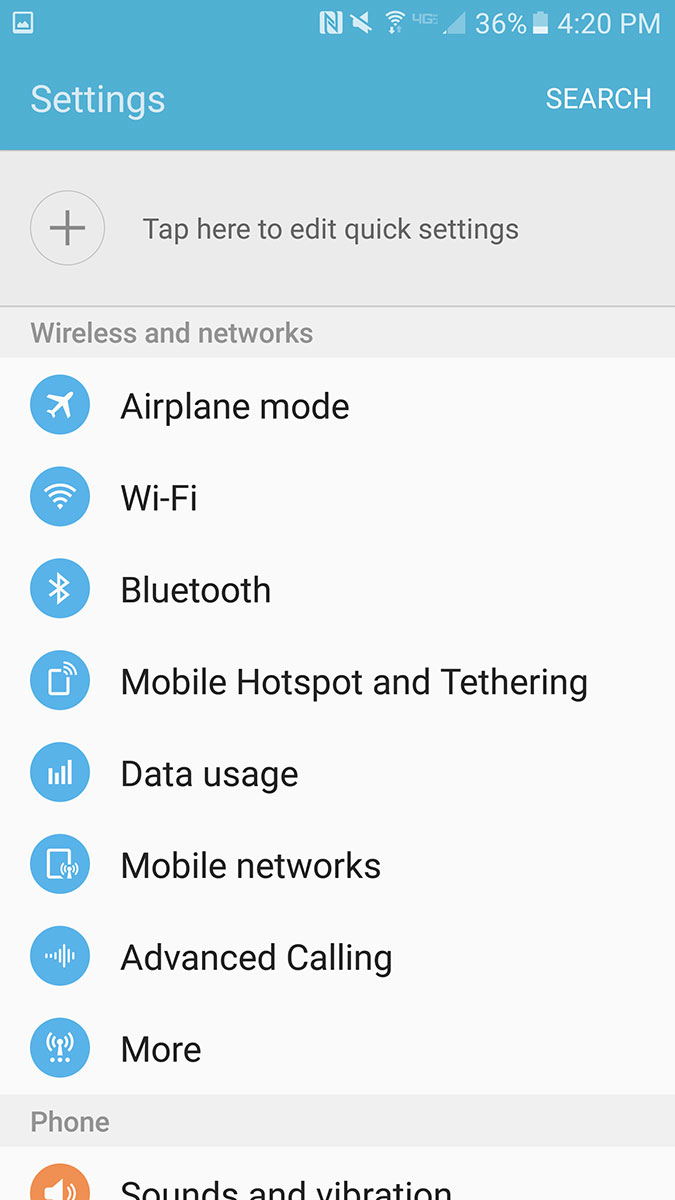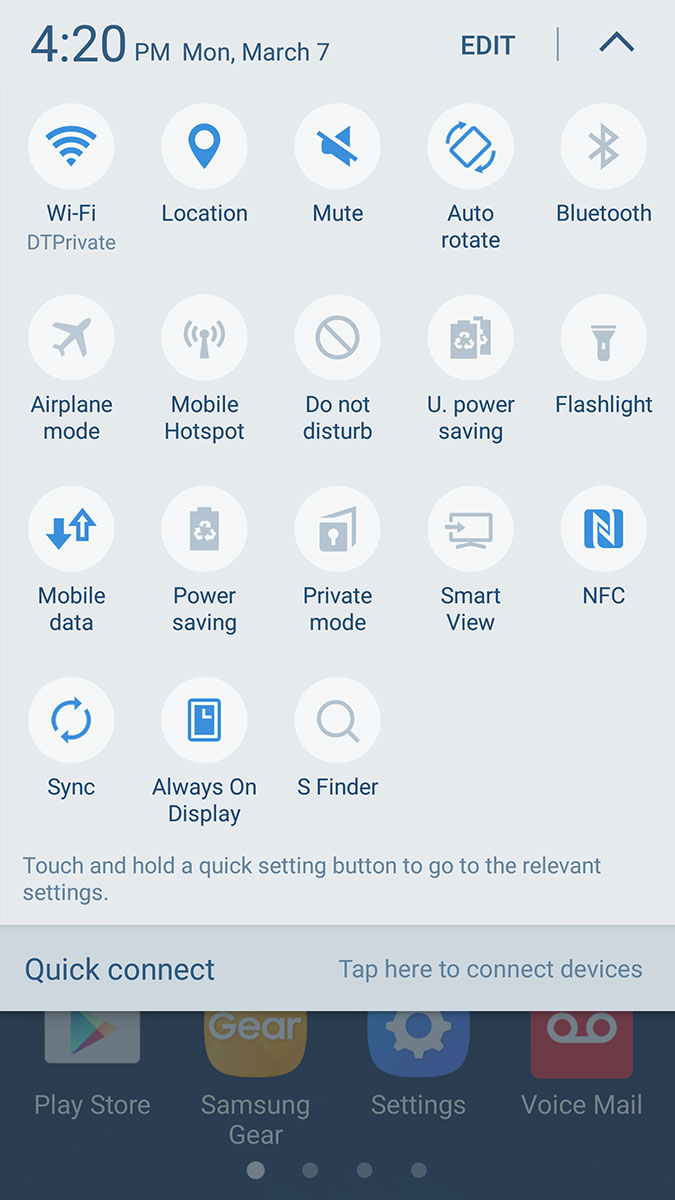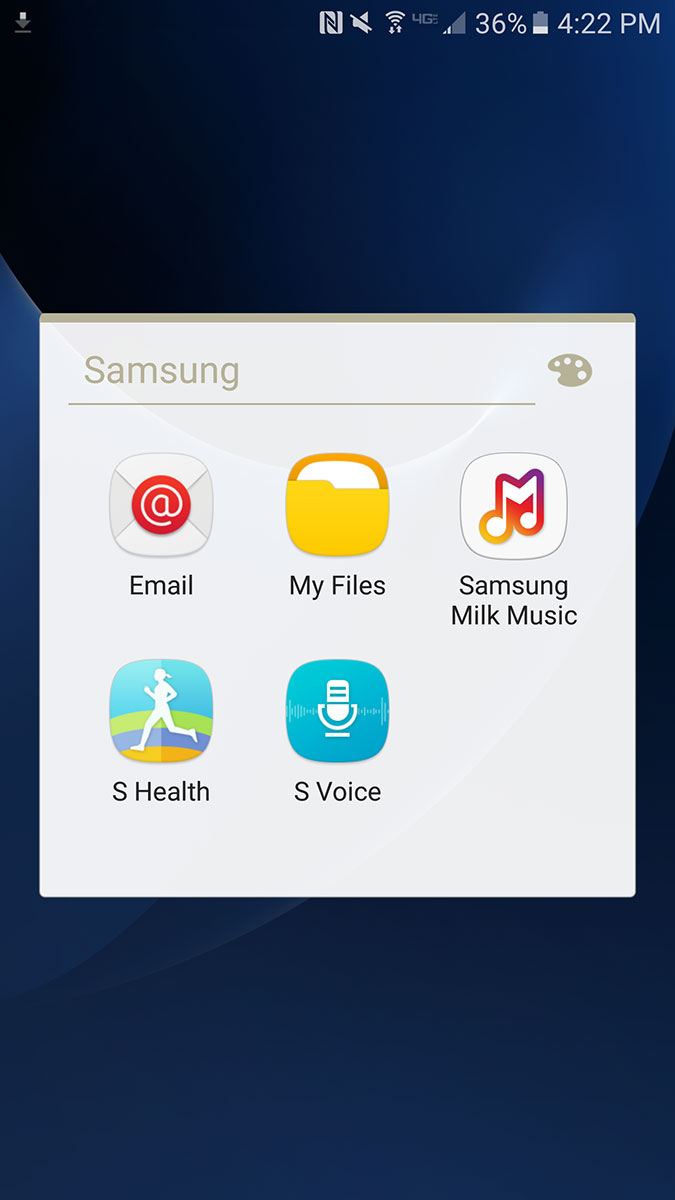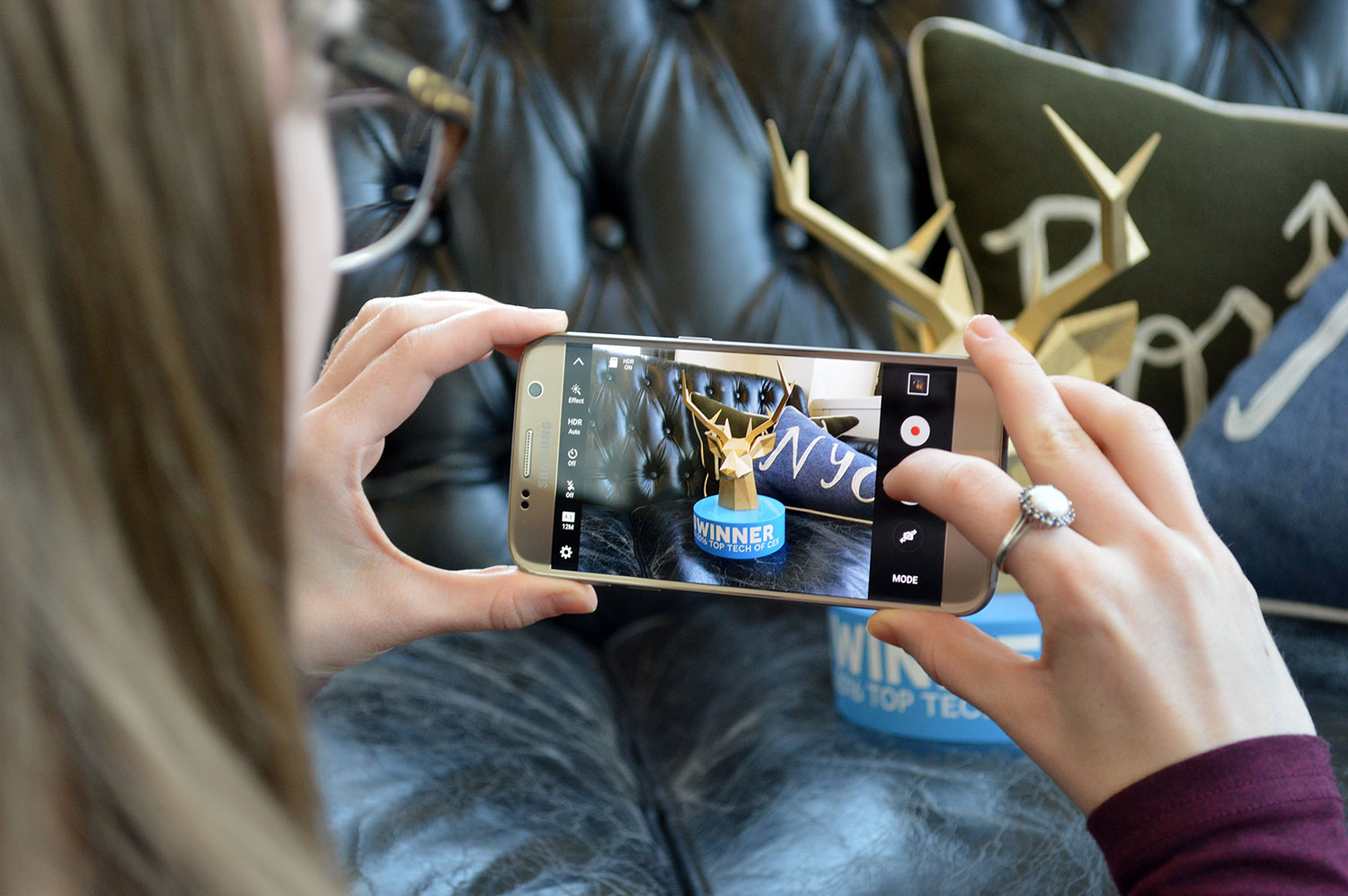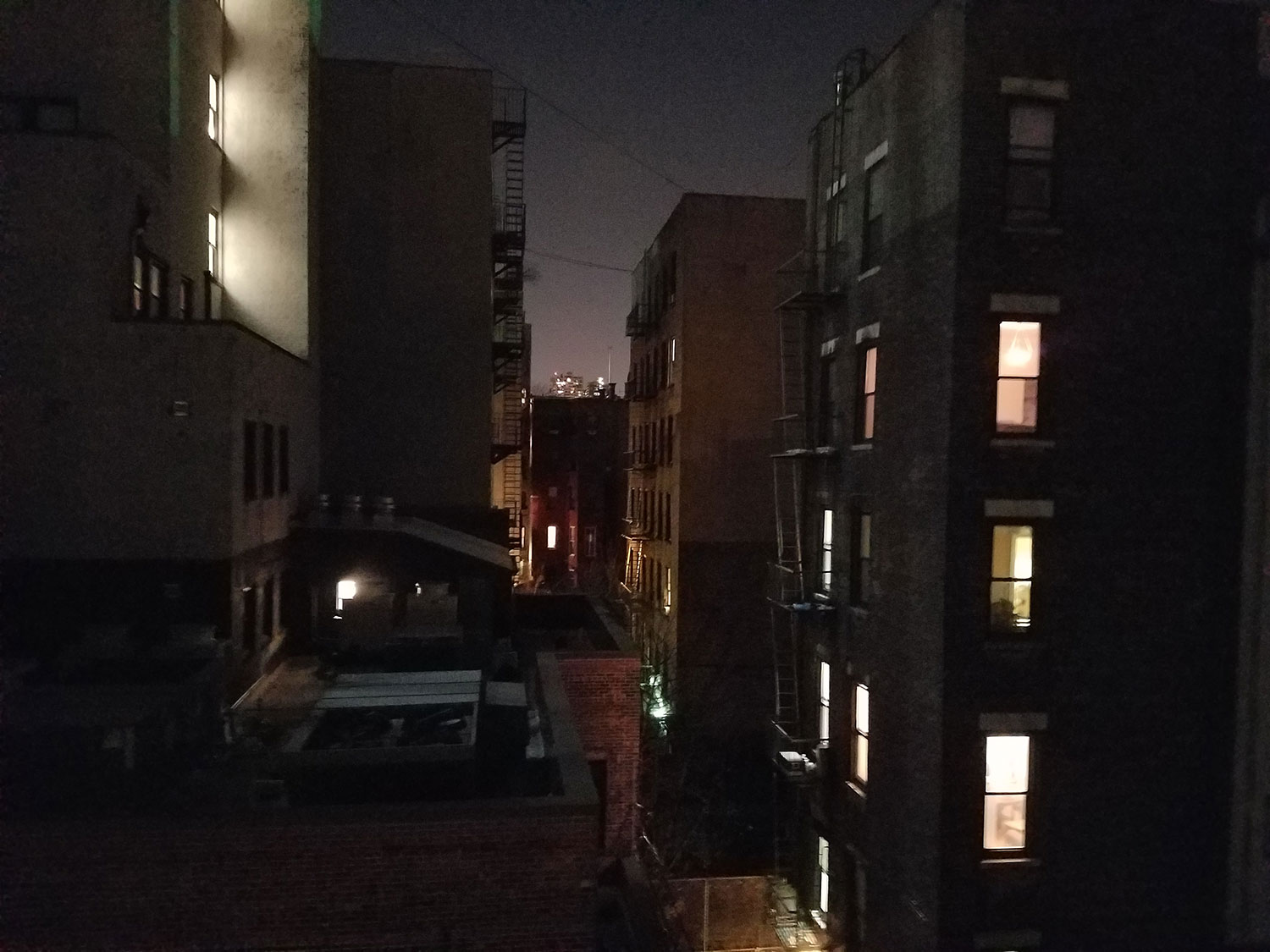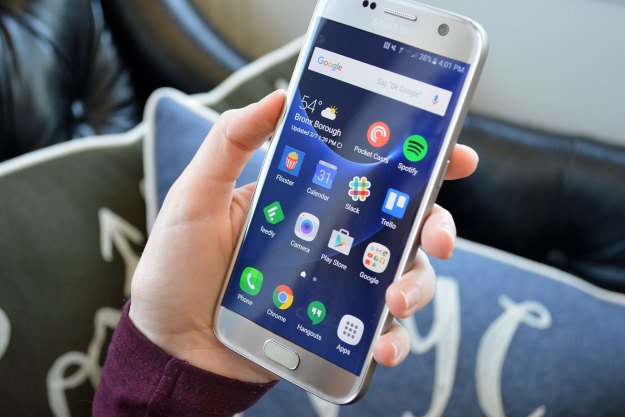
“Samsung’s Galaxy S7 is the standard-bearer for Android phones in 2016.”
- Gorgeous, waterproof, design
- Better battery life than Galaxy S6
- Camera shoots better in low light, focuses faster
- Micro SD card slot
- Powerful Snapdragon 820 processor
- Carrier locked with carrier bloatware
- All-glass design is fingerprint magnet
- Prone to glass cracking, expensive to repair
Samsung’s Galaxy S7 and Galaxy S7 Edge have arrived, and they lead the pack of Android phones in 2016. Neither of them reinvent the wheel from a design perspective, but plenty of notable changes help elevate them above previous Galaxy phones. There’s plenty to know if you’re considering migrating from an iPhone or another Android.
If you’re feeling curvy, check our full review of the Galaxy S7 Edge. This review will focus on the standard, flat-screened Galaxy S7. It may look the same as last year, but this new Galaxy packs a few new surprises, joyful moments, and disappointments under its glossy exterior.
Editor’s Note: We’ve updated this review after a few months of using the Galaxy S7. We’ve also added news of its availability unlocked from online retailers.
Beautiful, waterproof, fragile, fingerprints
If you’re at all familiar with the Samsung’s 2015 Galaxy devices, you know precisely what to expect from the Galaxy S7. This year, it’s all about refinement. The GS7 sports the same smooth, brushed-metal bumper sandwiched between front and back glass. It’s gorgeous. This improved design extends to the camera on the back, which still protrudes, but only about half as much as last year’s model.
With a 5.1-inch flat AMOLED screen that is the envy of every other phone, and a gentle curve to its back, the S7 is very comfortable to hold in your palm. It’s almost identically sized to last year’s Galaxy S6 (and the Galaxy S5, for that matter). Overall, it’s a comfortable smaller phone that most people should be able to hold (unless you prefer very extra tiny phones like the old iPhone 5S).
But glass is still glass, and the Galaxy S7 and S7 Edge are covered in the stuff, potentially making them the most fragile phones available this year. Because that Gorilla Glass is proprietary and curved on the back, it may also cost hundreds of dollars to replace broken or cracked screens, should the slippery phone fall from your grasp. Don’t buy a Galaxy S7 without a case.
The other major caveat to the glass design this year is how easy it is to cover in fingerprints. A week of use left our S7 so caked in fingerprints that it feels downright grimy to hold (another reason to get a case). If this sort of thing bothers you, consider a competing phone, or buying a nice case. Seriously, you’ll want a case. We can’t stress that enough.
We can’t complain for too long, though. Unlike many competitors, Samsung has water and dust-proofed the Galaxy S7. It has an IP68 rating, meaning dust should not penetrate its electronic innards, and you can submerge it in up to a meter of water for 30 minutes with no damage.
This should be an absolute relief for anyone who’s ever used their phone in the rain or near the water, and a return to form for the Galaxy brand. The Galaxy S5 was waterproof in 2014, but the peace-of-mind feature was missing from the Galaxy S6 devices and Note 5.
An audio mystery
We don’t have a lot to say on the audio front. The Galaxy S7 has a standard audio jack on its bottom and a single speaker. Sound from the speaker is expectedly tinny and weak, like all phones outside of the HTC One series, which have dual-front facing speakers. The full-volume sound from an iPhone 6S is still noticeably crisper than the S7, but neither device hits it out of the park.
Our audio experts haven’t had enough time to spend with it yet, but the S7 may lag behind this year’s other Android flagships when it comes to high-res audio. Our initial impressions were mixed.
Always On and Android Marshmallow
Following in the footsteps of innovations Motorola made two or three years ago, both Samsung and LG are adding Always On screens to their flagship phones this year. The GS7 always shows a clock when the phone is asleep. This feature should disable once you put the phone in your pocket. You can change this screen to show a calendar, as well.
It’s a safe investment if you want a top-of-the-line
There aren’t a ton of other software innovations. Samsung has loaded the phone with
But we digress. Samsung’s settings menus have grown cluttered and disorganized, and the S7 even lacks the fun Flipboard home screen app that previous Galaxy phones had, so you’ll need to download a launcher if you want to read news from the home screen.
Gamers also get a couple other small, but fun features. The Galaxy S7 can record gameplay, has a gaming Do Not Disturb mode, and lets you throttle your frame rate to save battery life through a special game launcher.
Samsung Pay, which lets you pay via NFC or even tap on a standard magnetic card reader, is still present. It appears that on some carriers, Samsung Pay will not come preloaded, though
A new app called Samsung+ is also on Google Play, but not loaded on the phone. It gives loyal Samsung fans access to perks and deals, but more importantly has customer service information and always-available 24/7 video support.
Available unlocked in the U.S.
The Galaxy S7 is one of the most popular phones in the world, but initially, it was only available locked to wireless carriers in the United States — that is to say, you could only buy a version that worked on your specific network. Thankfully, though, that is no longer the case.
Beginning on June 30, unlocked versions of both the Galaxy S7 and S7 Edge became available in the U.S. Samsung says the models work on all four major carriers — Sprint, Verizon, T-Mobile, and AT&T — and, unlike the carrier-locked variants, ship free of any third-party apps and services. The Galaxy S7 and S7 Edge are available on Samsung’s web store, Amazon, eBay, and brick-and-mortar retailers like Best Buy, Sam’s Club, and Target, and cost $670 and $770, respectively.
The unlocked Galaxy S7 and S7 Edge are, in terms of hardware, identical to their carrier-locked counterparts: they sport Qualcomm Snapdragon 820 processors, 4GB of RAM, water resistant exterior casing, wireless charging, and contactless payment with Samsung Pay. And they come with Samsung’s full manufacturer warranty.
The lack of overbearing apps is one of the best reasons to buy unlocked. The Verizon testing units used heavy-handed wording to try and pressure us into using Verizon cloud backup for managing contacts and vital info. Worse, the default messaging app was replaced with a Verizon Messaging+ app. We cannot think of a reason to ever use a messenger app created by your wireless carrier, and highly recommend you make Google Hangouts or Samsung’s messenger your default.
There are nine Verizon apps on the phone we reviewed, three Amazon apps, and a bunch of Samsung and Google apps. Verizon’s offerings include gems like NFL Mobile and Go90, which is a Verizon Mobile TV network app that we don’t particularly want to use. But they are unremovable.
Now that there is an unlocked version, you can avoid all this bloatware.
A battery case, Gear 360 cam, and more
The battery capacity of the Galaxy S7 improves to 3,000mAh this year, which is several hundred mAh larger than the S6, but the battery life still doesn’t last much more than a day.
Samsung is making its own battery case for the S7, which should extend your battery life by about 3,100mAh or roughly 2X the battery life of the phone. Because the battery is non-removable, this or a portable charger are your best options for days when you need some extra gas.
In addition to the battery case, Samsung is making a case with a camera lens enhancer built into it (like an Olloclip) and an updated wireless charging pad that sets the phone at an angle and can charge at high speed.
Finally, 360 cameras are the hot new item this year, along with virtual reality, and Samsung is never one to let a trend pass it by. To capitalize, it will release the Gear 360, a dual-camera 360-degree action cam that looks like a tiny robot out of Portal or Wall-E. By stitching photos together from two 15-megapixel fish-eye cameras, it creates a VR-ready spherical image or video. We tried taking a couple videos and stills on it, and though they won’t win any awards, for home movies and viewing, they do get the job done. If you own a Gear VR (our favorite mobile VR headset), you can almost instantly view your 360 videos in actual virtual reality.
One other cool note about the Gear 360 (read our full Gear 360 writeup) is that its handle splits out into a quirky little tripod. Unscrew that tripod and it can connect to any other camera stand.
A powerful, warm phone
If impressive specifications help you sleep at night, the Galaxy S7 may as well be Ambien. It runs on a new quad-core 2.15GHz + 1.6GHz processor, but the maker of that processor will vary by region. In the United States, we’re getting a Qualcomm Snapdragon 820 processor, but in the rest of the world, Samsung is using an Exynos chip of its own design. Samsung claims the new processors are supposedly about 30 percent faster than the Galaxy S6, and the integrated graphics processor is about 64 percent faster.
The Galaxy S7’s Snapdragon 820 processor runs circles around most every competitor.
Initial benchmarks are showing that the Galaxy S7’s Snapdragon 820 processor runs circles around most every competitor. Luckily, our model runs on the 820. It’s done very well in our initial tests, performing just above the Google Pixel C tablet in 3D Mark’s Sling Shot 3.1 test and narrowly outperforming the
It’s also a great phone for calling. We had no issues making or receiving calls on the Verizon network.
Be warned, however. Though it doesn’t get “hot,” the GS7 feels noticeably warm at most times, despite its new liquid cooling. Even with a case, this is a warm phone.
Aside from the processor, the Galaxy S7 comes with 4GB
An improved camera
Samsung really wants a better camera than the iPhone, and it has one, by some measurements. The S7 has a 12-megapixel rear cameras that operates faster thanks to an F1.7 lens (up from F1.9 in last year’s), and focuses faster thanks to its “dual-pixel” design. Samsung claims that every pixel in the lens also acts as a focus pixel, and that this is a first for smartphones.
In a direct shoot off in low-light and dark conditions, the Galaxy S7 often outperformed the
It’s a victory for Samsung, but the GS7 camera is not perfect. Samsung’s photos often come out warmer (more yellow and orange) than in reality, and than on the iPhone. So while it can grab a clearer, lighter shot, Samsung has some work to do in making that photo look realistic. Some S7 shots came out looking like they already had Instagram filters applied.
Selfies on the S7 were not noticeably worse or better than competing phones, like the iPhone.
Pricing in the U.S.
Beginning on June 30, you can get unlocked versions of both the Galaxy S7 and S7 Edge in the U.S. These models work on all four major carriers — Sprint, Verizon, T-Mobile, and AT&T. The unlocked Galaxy S7 and S7 Edge are available on Samsung’s web store, Amazon, eBay, and brick-and-mortar retailers like Best Buy, Sam’s Club, and Target, and cost $670 and $770, respectively.
The Galaxy S7 and Galaxy S7 Edge is available to order on all major carriers in the U.S. — AT&T, T-Mobile, Sprint, Verizon, U.S. Cellular.
The Galaxy S7 will come in black and gold to start, and prices range from $620 to $695. U.S. Cellular has the lowest price if you pay in full, but Sprint is offering the best price with an installment plan. Sprint also has the best overall deal with its 50 percent off a second Galaxy S7 offer.
- U.S. Cellular – $620 prepaid / $672 ($28 for 24 months) / $200 with 2-year contract
- Sprint – $650 ($27.09 for 24 months)
- T-Mobile – $670 ($27.92 for 24 months)
- Verizon – $672 ($28 for 24 months)
- AT&T – $695 ($23.17 for 30 months)
Check out a full list of locations here.
Warranty
The Galaxy S7 has a standard one-year limited warranty that covers the device and its battery, unless you do damage to it. If the waterproofing fails you may or may not get a replacement, so we don’t suggest you dunk it intentionally, and glass breaking is not covered. Samsung can choose to replace your device or repair it.
You also have the option to “opt out of arbitration” if you buy the Galaxy S7. Samsung gives users 30 days to opt out of the feature from purchase, and email and number to contact are in the warranty booklet. Arbitration takes away your right to file a complaint in the court of law against Samsung, if you believe it has wronged you.
Conclusion
The Galaxy S7 looks fantastic and is more comfortable to hold than the Galaxy S6 was last year. We’re very impressed with Samsung’s new camera, increased battery capacity, accessories, and waterproof design. Those benefits come on top of an industry-leading AMOLED screen and powerful processing power of the Snapdragon 820.
Our biggest worry is breakability. With more curved glass than ever, these phones may be expensive to fix if dropped, and they’re slippery as all hell to hold. Samsung hasn’t yet provided us details on how expensive it is to replace the glass in the GS7. We highly recommend a case of some sort. It will protect the phone, save you from an annoying amount of fingerprint smudges, and block some of the heat that comes from the phone.
If you’re concerned by breakability and you’re with AT&T, you could always buy the Galaxy S7 Active instead. It has all the same specs, but they’re packed into a more rugged body that can handle drops without shattering as well as extended dips in deep water. The Active has a bigger battery as well, which solves some of our battery concerns. So long as you don’t mind its looks, the Active is a better choice.
However, if you do want the regular S7 for its beauty, take advantage of the free Gear VR with early orders. The Gear VR was our favorite product of 2015, and we recommend you try it out if you get the chance. It’s the first chance you’ll get to try legitimate VR at home.
Though we prefer the Galaxy S7 Edge because of its larger screen and battery, the standard S7 is an absolutely fantastic phone. It’s a model for what phones will be like this year, and is a safe investment if you want a top-of-the-line
Editors' Recommendations
- The 20 best Samsung Galaxy Watch faces you should be using
- Samsung’s Galaxy AI is about to get a lot more useful
- Samsung’s newest Android tablet is a perfect iPad alternative
- Have a Samsung Galaxy S23? Don’t update your phone to One UI 6.1
- A new version of the Samsung Galaxy S24 could be coming soon


